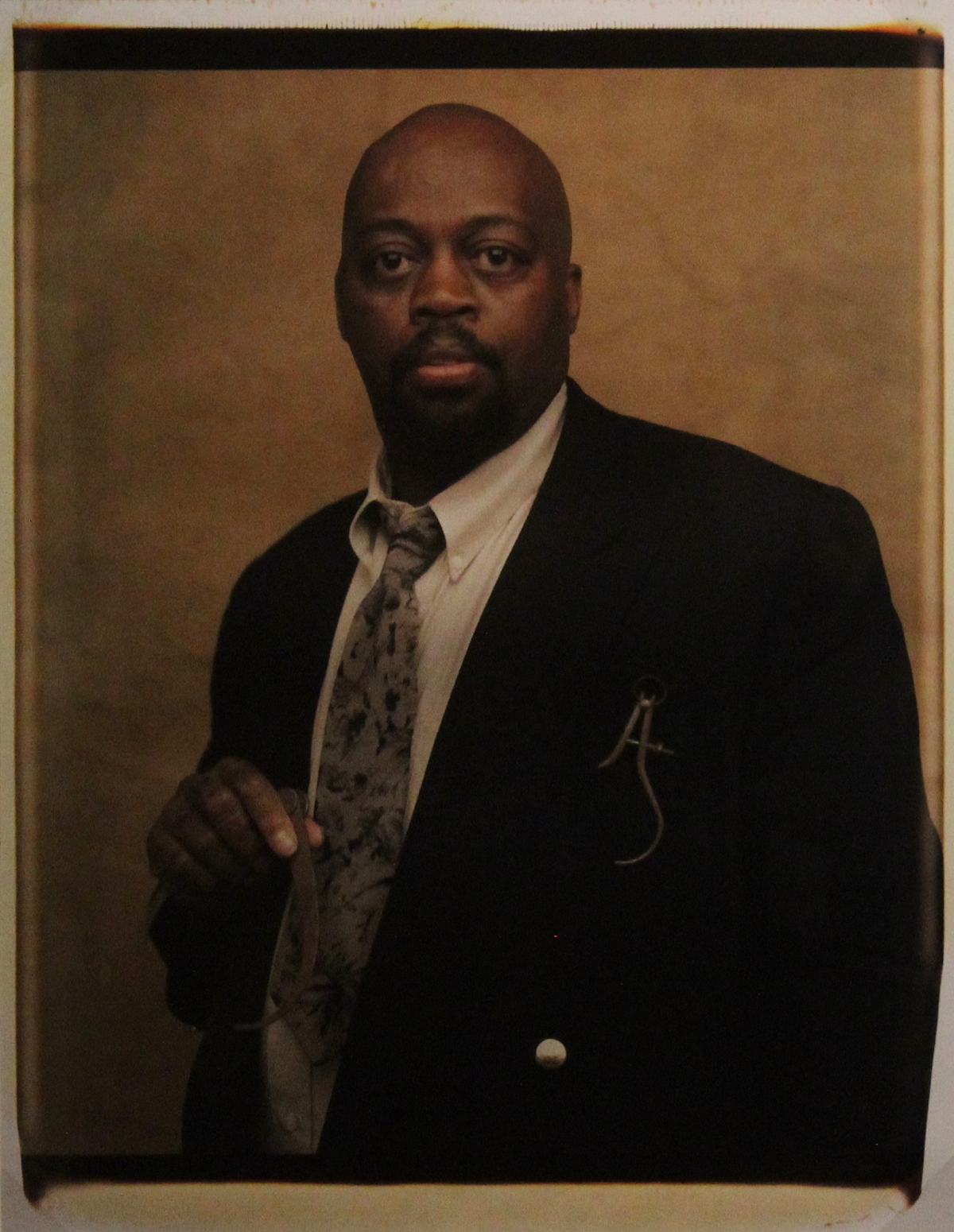
The image of beloved New Haven photographer David White, Jr. is an image that plays with time. It starts with the obvious anachronisms, from the instrument in White’s pocket to the sepia background, even as it’s clear that White is a modern man. The melted edges of the image, though, are another layer of history. They’re not digital artifacts, but the blurred edges of a process few people see anymore: the development of a Polaroid, and in this case, an especially hefty one — a 20 x 24 camera, “so rare only five were initially manufactured,” an accompanying note explains. The photograph was taken in 1993. Why the Polaroid? Why the anachronistic style? And why is it paired with an image from 1815?
Peeling back the layers to answer these questions is much of the pleasure of “Instants: Linda Lindroth’s Polaroid Portraits,” organized by Collections Manager Mary Christ and running now at the New Haven Museum through June 10. The show consists first of several of Lindroth’s large Polaroids. Lindroth, who has practiced photography in New Haven since the mid-1980s, was part of the Polaroid Artists Support Program, which, for decades until the company’s bankruptcy in 2001, gave artists cameras and film to produce fine art using Polaroid cameras. “Aspects of creating these large-format Polaroid portraits shared similarities with the process of creating an eighteenth-century painting or a nineteenth-century daguerreotype,” as Christ notes. The camera was large and not portable. Photographer and subject had to travel to a Polaroid studio in Manhattan to use it. Leaning into this, Lindroth had subjects dress for the occasion, complete with props. Lindroth crawled under the camera to give directions to her subjects.
Some of Lindroth’s portraits were made “for expected reasons,” Christ notes, such as “milestone birthdays, professional achievements, in anticipation of the birth of a baby.” White’s image, however, was part of a show put on by the John Slade Ely House in 1994 called “The Visual Stage: Art In and Around Theater.” One part of this show — “Archeology/Body/City,” which Lindroth organized with architect Craig Newick and director Michael Rush — “was inspired by the then recent discovery of a colonial-era African American burial ground in New York City” and featured Lindroth’s portraits of “people ‘in character’ as both historical figures from colonial Manhattan, as well as contemporary individuals involved in the 1990s archeological excavation of this previously unknown history.”
White, a colleague of Lindroth’s, posed as an archeologist. But the image also followed in the grand tradition of artists depicting other artists in their work. So for the present-day exhibition, Christ paired it with an image from the New Haven Museum’s collection, a pastel drawing made by artist Ralph Earl sometime between 1800 and 1815 of engraver Amos Doolittle, also known as the Paul Revere of Connecticut for his actions as a soldier during the Revolutionary War.

The web of connections — those within Lindroth’s work and those that Christ has added by pairing Lindroth’s images with works from the museum’s collection — makes “Instants” an engrossing visit. Near to White are portraits of New Haven actor, performance coach, playwright, and director Jeff Burnett, playing George Clarke, who was governor of the colony of New York from 1736 to 1742. The idea was to prompt viewers “to consider how the actions and public policies of the British colonial government affected the lives of those who lived under its rule, in particular members of the African American community.” Christ has paired this with an engraving of Jared Ingersoll, “who held the unenviable position of stamp agent for the Connecticut colony in the decade before the Revolutionary War.”
Next to Burnett is a portrait of actor Nathaniel Freeman, whom Lindroth stopped on the street in New York to ask if he was willing to have his picture taken, as a “descendant of colonial New York’s African American population, many of whom lived their lives in slavery.” Freeman agreed; he related at the time that he always sought out projects that “reflect how I think and feel about the world, past and present.” Latching onto Freeman’s profession as an actor, Christ has paired it with a 19-century sketch by artist George Henry Durrie of the Shakespeare character Falstaff.
Other portraits in the exhibition include one from 1988 of H. Catherine Skinner, senior research scientist in geology and geophysics at Yale; Christ has paired her with a portrait of 19th-century educator and scientist Julia Dyer Merrill. A Lindroth portrait of art historian and curator Helen Achbar Cooper is paired with one of 19th-century historian John Warner Barber. His “contributions to local history, and to the New Haven Museum collection, are impossible to overstate,” Christ writes. “What would you choose to preserve to document life in New Haven today? How do the visual arts, including photography, help us learn about people and events from the past?”
Lindroth’s photos and Christ’s framing of them provide one answer to that question. In setting up all kinds of connections and parallels, from the present day to the 1980s and 1990s to the 18th and 19th centuries, “Instants” invites speculation about what the next iteration of such a show might look like (a collection of iPhone photos, maybe?) and how the medium conveys both the reality of its time and a certain timelessness; how it reflects the way some things come and go while others seem to return again and again, in altered but still recognizable forms.
“Instants: Linda Lindroth’s Polaroid Portraits” runs at the New Haven Museum, 114 Whitney Ave., through June 10. Visit the museum’s website for hours and more information.

That's Mr. White! I grew up with Mr. White snapping photos of me and other folks! I've never seen this photo! I must catch this exhibition!